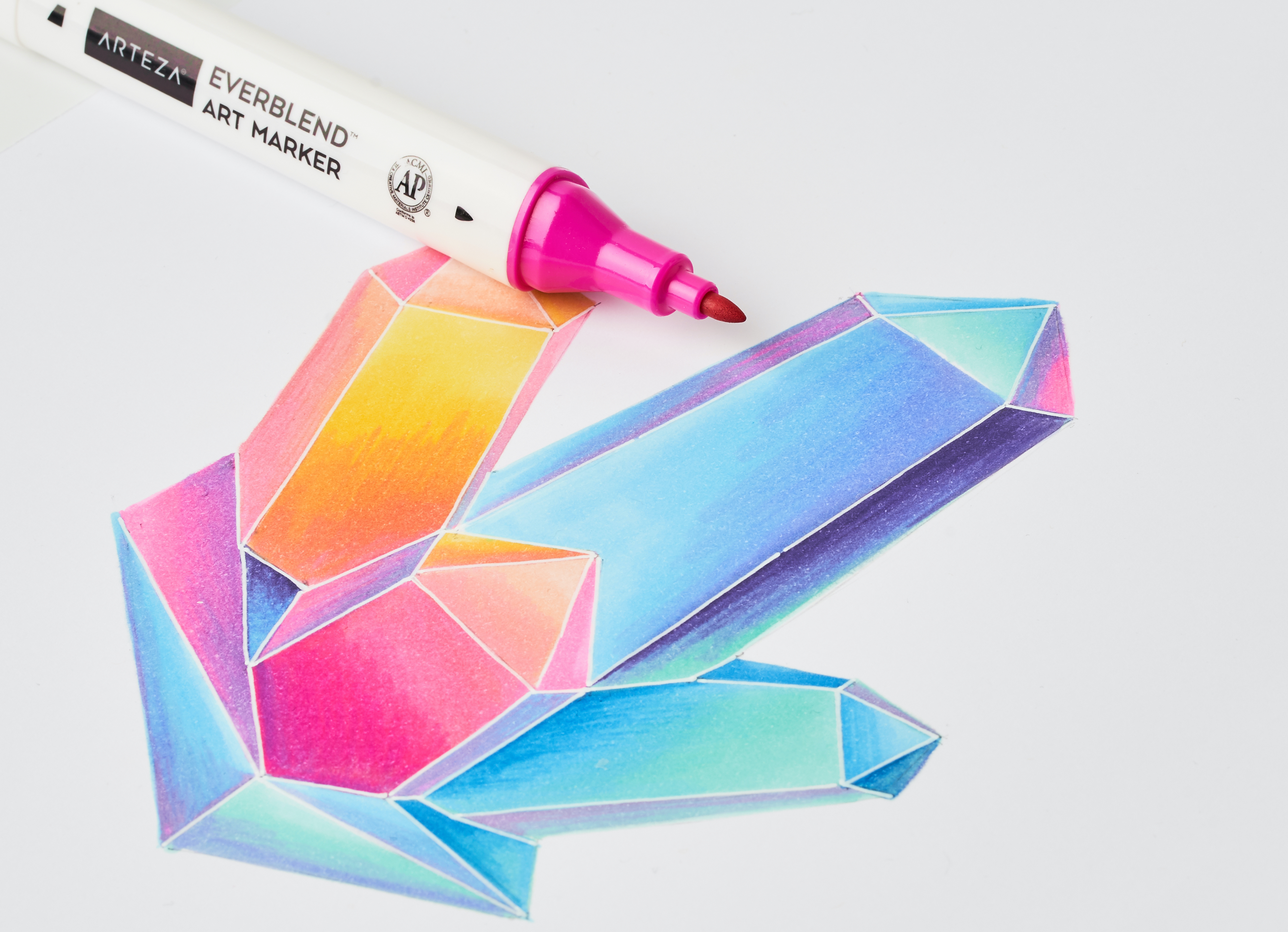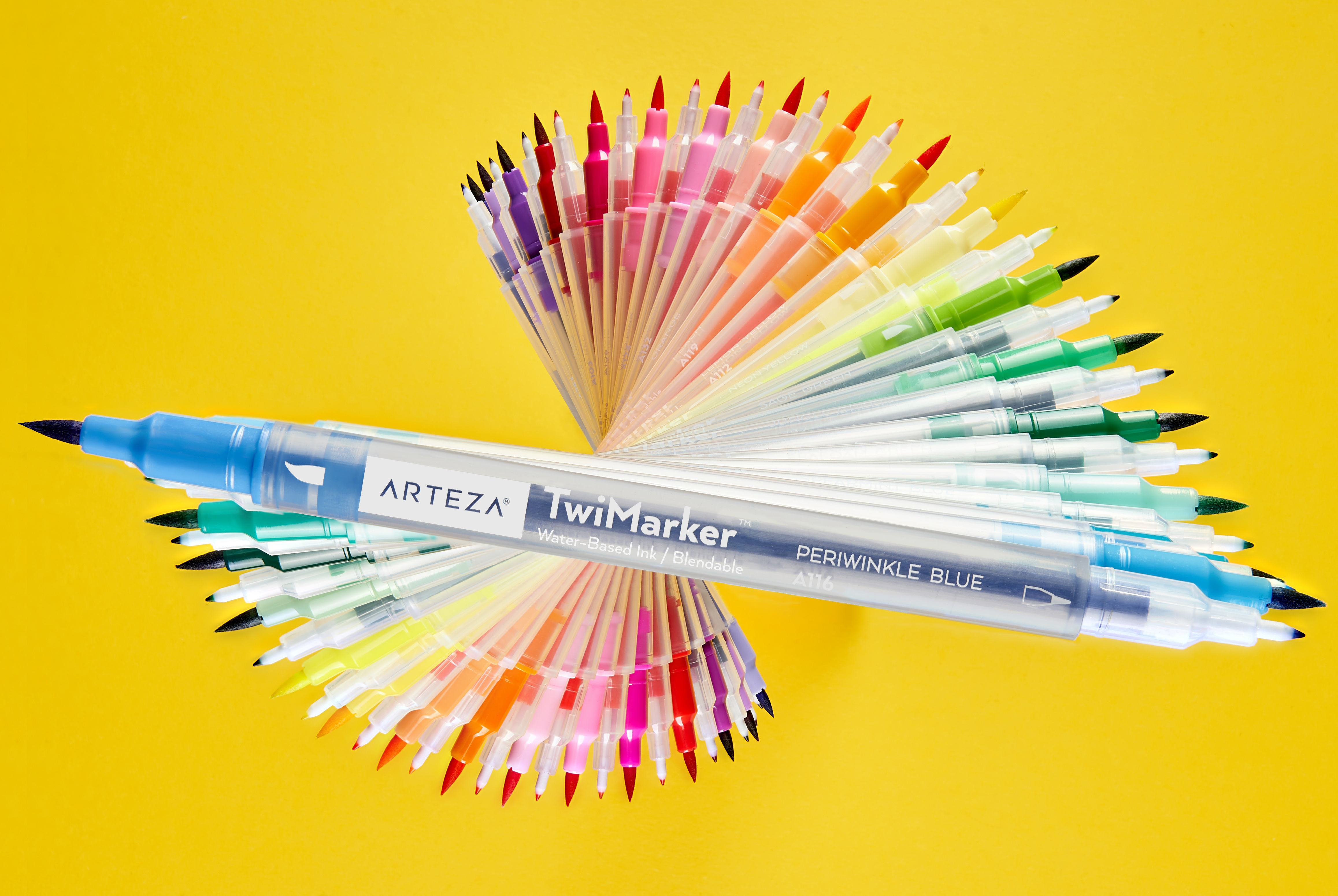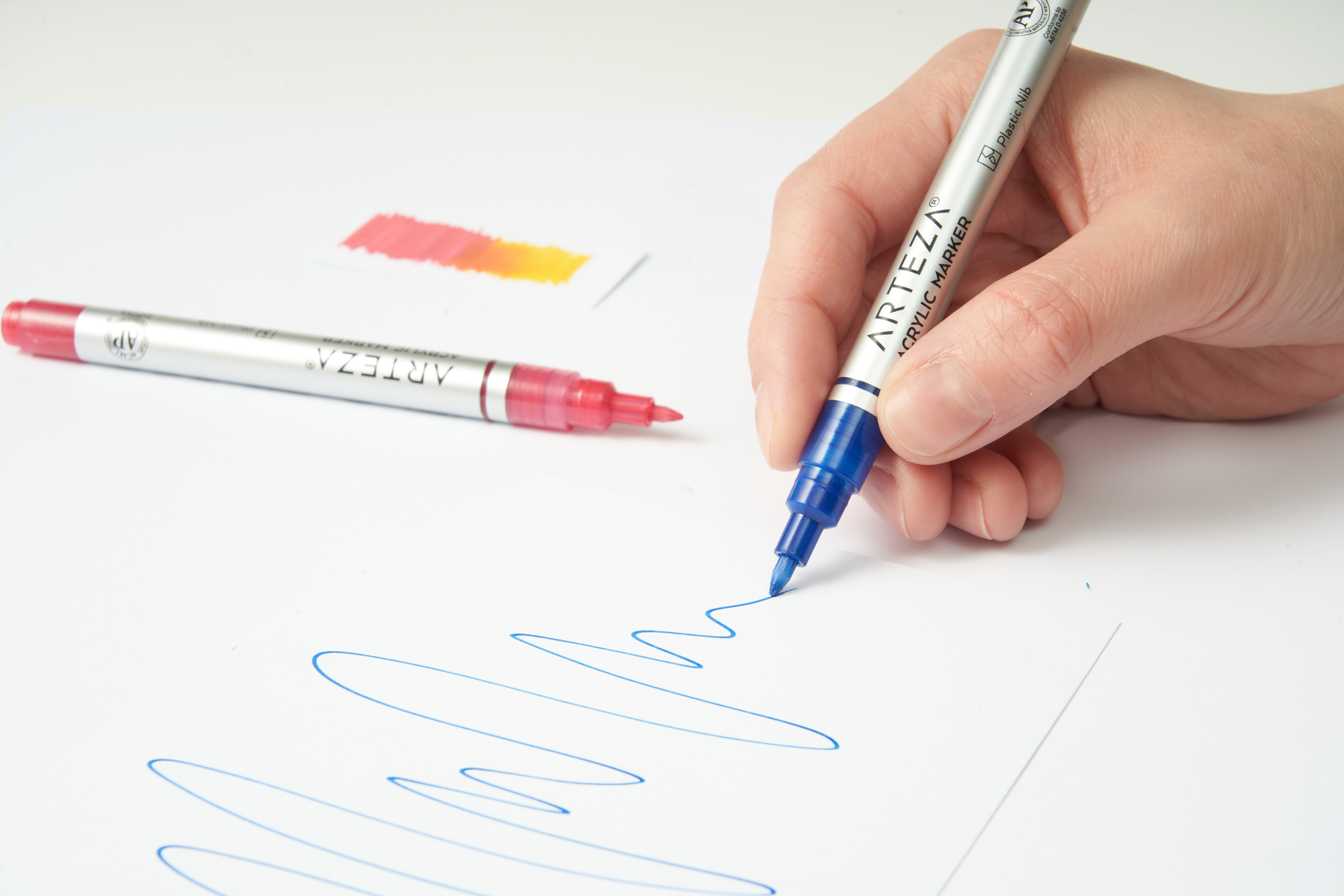Your Guide to Art Markers
People love them, protestors rely on them and illustrators swear by them. What is this versatile tool? The marker. The uses for markers are unlimited. Their bold colors and lines make them perfect for writing messages on posters, making colorful drawings or marking boxes when moving. And, who hasn’t felt the sting of the teacher’s red marker lines on an essay or homework assignment? For artists, markers are invaluable. Known as art markers, these specialized markers are designed to achieve many of the same techniques you can get with paint. Plus, they offer the convenience and control of a pen but are able to make a variety of marks in different shades and widths. Today’s art markers come in tons of brilliant colors, including metallics, neons, and pastels. They can be layered and mixed like paint or produce smooth solid lines. As more and more contemporary artists have discovered their ease of use and their almost unlimited color range, it’s no wonder the popularity of art markers continues to rise.
What Are Alcohol Markers?
We can’t talk about markers without a discussion on ink first. People have been using ink to make drawings since cave days. Back then, the ink was made using soil mixed with animal and plant fluids. Drawings were made with a stick dipped into this ink. The early Egyptians created solid black ink sticks with a mixture of ground soot and vegetable resin that could be used when moistened with water. By using rust instead of soot, they create red ink. It wasn’t until the 17th century, when Europeans combined iron salt with tree bark tannins, that the blue and black ink common today was created. The recipe for ink hasn’t changed much but is still a combination of pigment and a carrier liquid of resins, oils or solvents. Natural substances are still used, as well as new synthetic ones.
How to distribute the ink in a fine line became more and more important as written communication came into being. The stick of the caveman would never suffice, so instruments to carry the ink began their evolution as well. Hollow sticks or reeds whittled to a point were the first pens. From there the wing feather of a duck or quill was used. In the 1800s the steel pen nib was invented. Later, a pen that could carry the ink within a barrel, the fountain pen, was developed and the writer no longer had to continuously dip the nib in ink.
In 1954, Sydney Rosenthal invented a pen with a felt tip. Attached to a bottle of ink, the wool felt tip absorbed the ink, allowing the user to create a bolder and more saturated and permanent line. They became extremely popular for labeling as well as lettering on outdoor signs and posters.
Around 1993, marker users began requesting that manufacturers create markers that didn’t contain strong-smelling solvents. The answer was to replace these solvents with an alcohol base. These markers are able to make the same vibrant strokes and are completely safe for all ages to use. There are also water-based markers. Both are the preferred markers among graphic designers, manga artists, illustrators, and fine artists today.
How Are Art Markers Made?
Markers are made of four parts—the body, the tip, the reservoir, and the ink. Here’s how each component is made:
- Body - The body of the marker includes the barrel and the cap. Both of these are created by a process known as injection molding. Plastic resin is heated to a high temperature and once it is melted it is injected into a mold in the shape of the barrel and the cap. Once cool, the hardened shapes are removed from the mold.
- Tip - Unlike a paintbrush, the tip of the marker is not made of natural fibers but is made by mixing a powdery substance with water that is placed into a mold of the proper shape (pointed or angled, thin or wide) and baked.
- Reservoir - This is the inner barrel that holds the ink. It is made of polyester and is placed inside the barrel and filled with ink. Once full, the tip is added and covered with the cap.
- Ink - The ink is made by adding alcohol or water to dissolve the dye. Other additives are mixed into the solution to allow the ink to disperse properly once pressure is applied to the tip.
More Than Just Art Markers
Although art markers are the main focus of this article, there are other types of markers with specific uses, which can also be added to the artist’s tool kit.
- Permanent markers - As the name implies, permanent markers contain ink that’s made to withstand rubbing, water, or weather conditions. This durable ink cannot be removed once applied. It can be used on most surfaces and is commonly used for labeling, lettering, and signage. Because of the durability of the ink and the bold marks they make, permanent markers are popular with mixed media and graffiti artists.
- Highlighters - An office and school staple, highlighters contain neon-hued transparent ink. They are usually permanent and dry quickly. When the tip is stroked across printed text, the user can still see the text. This makes highlighters a useful tool for studying and color-coding.
- Whiteboard markers - Also known as dry-erase markers, these markers don’t contain the substances that make permanent markers imperishable, allowing the user to remove their marks whenever they desire. They come in a range of bright colors and work especially well on nonporous surfaces, such as whiteboards. Their most common use is in the classroom or office for presentations and brainstorming sessions. The marks can easily be removed with a paper towel or cloth.
- Security marker - These markers contain specialized ink that once applied appears invisible. The marks can be revealed by shining an ultraviolet light on them, making these markers useful for marking valuables. If the valuable is stolen and recovered, it can be identified as the owner’s by simply shining the UV light on it.
- Election marker - Created to prevent fraudulent voting, these unique markers contain a photosensitive element that makes the ink indelible and is used to mark voters’ fingers. Fingers are checked before the ballot is given to ensure the voter isn’t trying to vote more than once.
- Porous point pen - These pens are a valuable draftsman’s tool as their tip is made of a porous material and doesn’t widen when pressure is applied. This allows the user to get a consistent line, which is necessary when drawing plans to scale.
Best Surfaces for Markers
Art markers work best on smooth surfaces that allow the ink to glide across the page. Many artists, however, prefer a slightly textured surface that lets the ink spread. Whichever surface is used, there are two important things to consider—weight and acid amount. Heavier weight papers keep the ink from bleeding through, essential for those who wish to use both sides of the paper or artists who use markers in a sketchbook and want to keep the blank pages free from stains. It is also important to use a surface that is acid-free or archival. If the paper contains acid, it will affect how the artwork looks in the future. Acid-free paper prevents the work from fading and yellowing over time.
What Are the Best Art Markers?
For those looking for quality markers at a good value, Arteza offers several different kinds. Here is a list of best-sellers for beginners, intermediate artists and pros.
- Alcohol Markers - EverBlend alcohol markers are vibrant and rich markers that come in a wide range of blendable colors. They make creating seamless gradients and smooth, solid areas of color effortless. Arteza provides alcohol markers in a variety of sets, including special collections of skin tones, pastels and gray tones. For easy corrections, some sets include a clear blender marker for lifting color from the page. These are the must-have markers for illustrators, designers, architects, comic book artists, and hobbyists.
- Art Markers - Arteza offers art markers in convenient sets that contain a broad variety of bright and vibrant colors that can blend and create subtleties and stark contrasts in whatever piece you’re working on. These premium sets of TwiMarkers and acrylic markers are ideal for the artist who wants to take their work up a notch for a more professional and polished look. Veteran artists will appreciate the wide spectrum of colors along with the high quality of these markers.
- Chalk Markers - When you want the look of chalk without all the dust, choose liquid chalk. These high-quality alternatives to traditional chalk have incredible staying power and can be easily wiped away, without leaving a trace behind. Great for menu boards, signs, and posters.
- Dual Tip Markers - Double the fun with dual-tip markers. No need to keep two separate sets of markers when you can have these. Each one includes a fine-point on one end and a wider tip on the other. Perfect for hand lettering, drawing, and coloring.
- Dry Erase Markers - These markers are designed with ink that can be easily removed from non-porous surfaces, such as treated whiteboards, metal, glass, and some acrylic materials. You can clean your surface with an eraser, a paper towel, or sometimes even your hand. Arteza has dry-erase markers in a vast array of colors. Great for keeping up with monthly calendars, ongoing grocery lists in the kitchen, or conducting brainstorm sessions and team exercises in the classroom and conference room.
- Fabric Markers - Fabric markers are specifically made to be used on fabric. They contain permanent ink, so your designs won’t come off in the wash. Each marker moves smoothly across most textures of fabric so it’s easy to add your own unique drawings or messages to T-shirts, sweatshirts, tote bags, pillows and more.
- Highlighters - Make it easy to review your work with a great set of highlighters. There are many different styles of these helpful pens and markers out there these days that come in an array of colors. Mostly, you will find them in fluorescent pink, orange, yellow, green and blue, but they also come in many other colors. The best style of tip to have is the chisel tip, which can be a narrow, regular or wide style. This enables you to make precision highlighting over words. The fluorescent color makes it easy to quickly find important words and information you need to reference at a later time. The difference between markers and highlighters is that the fluorescent color of a highlighter jumps out at you making it more visible. The ink is also transparent, ensuring the visibility of what it is you are highlighting.
- Metallic Markers - Metallic markers are markers that are filled with ink made with special pigments that create a metalized look. These markers allow you to write in gold, silver, bronze, and to add shine to your artwork. They also typically show up brightly on black paper. Metallic markers are a great way to add impact and a touch of sparkle to your artwork. They come with chisel tips or bullet tips for wide and thin lines. They work on either smooth or slightly textured surfaces.
- Permanent Markers - They’re markers filled with ink that’s formulated to remain permanent on any surface. These markers can be used for writing on paper, plastic, rocks, metal, glass, and so much more. The bold ink is lightfast, meaning it will remain the same for a long period of time. They are especially suited for writing on anything that will be used outside, such as signs and posters.
- Real Brush Pens - Arteza Real Brush Pens offer the convenience of a pen with the artistic freedom of a brush. They are well suited for lettering and painting. The versatility of the flexible nylon brush tip lets you create a variety of strokes ranging from wide strokes to fine details. The Real Brush Pens are filled with water-based ink that’s translucent and perfect for creating the look of watercolor paintings.
Alcohol-Based vs Water-Based Markers
Alcohol-Based Water-Based
Permanent Non-permanent; water-soluble
Archival Non-archival
Dry fast Take longer to dry
May have fumes No scent
Types of Tips
The type of tip on a marker directly affects the width of the line it makes. There are three main types of tips—fine point, bullet, and chisel. Some markers have dual-tips, which means there is a fine point on one end and a chisel tip on the other. This is convenient and allows artists to switch back and forth easily. Dual-tip markers also cut costs—it’s going to take longer for your go-to markers to run out of ink.
Each tip has a specific use.
- Bullet Tip - This tip comes to a rounded point and is good for making medium size lines as well as filling in medium size areas. This tip comes in handy when adding shadows within a drawing. It is often used for hand-lettering as well as drawing.
- Fine Point - The fine point is crucial for making very thin lines and getting into tight spaces. Artists frequently use this tip to add small details such as eyelashes, veins on leaves, highlights or when just a dot of color is needed. It’s also a good tool to use for hatching to create a subtle contrast.
- Chisel Tip - This is the widest tip and is cut at an angle. The tip of the angled edge allows the artist to get into smaller areas while the larger side can cover larger spaces without overlapping lines. The chisel tip is also used to blend colors and create subtle gradients. When wide letters are needed to make a bold statement, the chisel tip is the best choice.
It’s also a good idea to use markers that have replaceable tips. Arteza offers marker sets that include additional tips and a tiny tweezer to make it easy to pop them in and out whenever the tip gets worn down. This is a great way to save on ink and make markers last until the last drop!
How to Use Alcohol Markers
There’s no trick to drawing with markers. All you need is a marker and a sheet of paper and you’re ready to begin. Although you can start drawing right away with them, it’s always a good idea to start with a light pencil sketch, as once you lay down your lines with the marker, you can’t remove them. The amount of color you get depends on the amount of pressure applied to the tip. The more pressure applied, the darker and more saturated the color will be. For very light lines, apply less pressure. Many artists begin with the lightest shades first and then add darker shades in a series of layers. They do this because they can always go back and darken an area but making a shade lighter is difficult and nearly impossible. Having a blender marker will allow you to lighten some shades, but deciding where the lighter areas are going to be in a composition before putting marker to paper is the best way to maintain the correct color intensity.
Arteza’s Top Affordable Markers
Beginning to create art with markers is very affordable. Artists of all ages and skill levels are always looking for good cheap art markers. Arteza provides a variety of ways to purchase them that fit any size budget. From art bundles and jumbo sets to single-color open-stock selections, Arteza makes it easy to have high-quality markers at a good value. Here is a list of some of the most affordable markers Arteza offers.
EverBlend Art Markers
EverBlend markers use alcohol-based ink and come in a wide selection of colors. They have dual tips and an ergonomic design. They are prized by novice and professional artists alike for their durability, vitality and competitive pricing.

- Classic Tones, Single Color - Pack of 4 - The best way to add to your collection or replenish your favorite colors.
- Skin Tones, Single Color - Pack of 4 - Never be without the perfect skin tone. Choose from a range of tones to restock or find the exact match.
- Gray Tones, Single Color - Pack of 4 - Great for value studies, Arteza’s open-stock selection of gray tones gives you everything you need for an entire grayscale.
- EverBlend Art Markers - Set of 60 - Enjoy having 60 colors at your fingertips as well as a convenient carrying case with storage for 72 markers.
TwiMarkers
These unique markers contain water-based ink and have a .4mm tip on one end and a broader brush tip on the other.

- Sketch TwiMarkers, Dual Tipped - Set of 48 - Discover endless color combinations with their blendable, water-based ink that works well for calligraphy, note taking, doodling and more.
- Sketch TwiMarkers, Dual Tipped - Set of 100 - This is the ultimate starter set with every color imaginable for journaling, lettering and blending.
Acrylic Markers
Use these water-based pens on paper, glass, cardboard, wood, porcelain, metal, textiles, and plastic. They dry fast and are low odor.

- Acrylic Markers - Set of 20 - This set contains 17 classic colors and 3 metallic shades along with replaceable tips.
- Acrylic Markers - Set of 40 - Get 37 traditional shades and 3 metallic hues in this jumbo set that also includes replaceable tips.
Are you feeling inspired to create art with markers? There’s no time like now! Make sure to also check out our suggested products below and shop set for your creation.

















